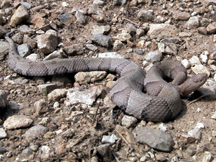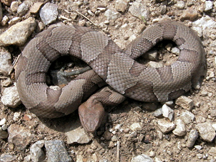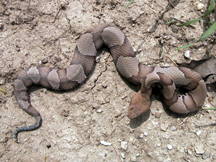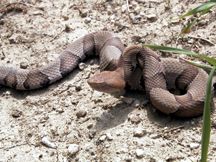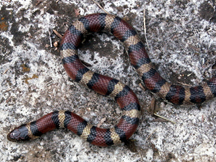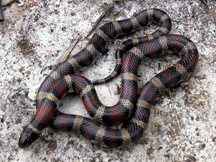
5-03-03
Trip Details
Location: Wabaunsee County, Kansas
Conditions: From cloudy and cool in the morning, to partly cloudy and warmer in the early afternoon, to mostly sunny and warm in the late afternoon. 60 - 75 degrees.
Time: 10:30 am to 5:00 pm
Herpers: Jim Scharosch & Matt Ricklefs
After a five star stop over complete with a game of four-square, a prime rib dinner and the great company of Jill, Jordan, Greg and Brian at Jim's sister Jill’s house in Kansas City, we started out fresh for our first true day of herpin’ on Saturday. The morning was favorable, but went through a myriad of weather changes through the day. By 10:30 am, when we got to where we needed to start it was fairly cool, but still a little sunny. In the morning we had the most variance in the weather, and were not sure what to think. Still, last year on our first day it was cool, cloudy and rainy. So, we were appreciative of what we had. This year, we had our spots picked out from the year before, so we had a much better plan to begin with. As it was still a little cool and cloudy, we decided to hit a house we had access to the year before. It wasn’t great, but did help complete some of the smaller species we needed to document. And, it always pays to keep checking spots where you find anything, as you never know what may pop up. We were soon to find this out. The spot had changed little and we did our rounds. We found our normal complement of Ringneck Snakes and Great Plains Skinks. These are very common throughout Kansas. They are still fun to find, but after a while, you see a lot and you become ready to move on quickly. Still, these were the first finds and we were off and going. Slow going. We walked around and turned a lot of stuff with no avail.
We came to near the end of looking, a small stone building that looked favorable and where we had documented a juvenile racer the year before. After turning some rocks, we got our first big find, a Speckled King Snake (Lampropeltis getula holbrooki x splendidia).
We reference this as an intergrade, as in this part of the state there is much integration between the Speckled and Desert King Snakes. It is evident in the baring across the back. On young Speckled Kings there is usually barring, but this baring remain s into adulthood and does not show the true speckling of a pure holbrooki. This was a very pretty specimen and was about sixteen inches long. We took a lot of pictures as this was the first big find and this is usual for the first big find. After documenting it went on it’s way as did we. We walked back to the van and I decided to look in the back of an old truck. It looked very snaky and I was hoping a Black Rat may materialize out of the background. It did not. However, a Gray Tree Frog/Cope’s Gray Tree Frog (Hyla chrysoscelis or versicolor) was there to oblige instead!
Now, as both species of Gray Tree Frog reside in this state we could not discern the difference as this is not ab easy task. This was a welcome find. Although common in many areas we have not documented this species in Kansas. Besides, tree frogs are just pretty cool anyway. But then again, aren’t all herps?!? This one was about two and a half inches long. It had the beautiful shades of gray with the bright yellow under the legs. we took it to a log for natural pictures and it blended in perfectly. It is odd to say the log was natural only in the stance that it did choose the old chevy as it’s abode for that day. Home is where you make it. That was it for this spot and we decided to move on. Unfortunately I left something behind...
We were going to go to a man made lake then, but the weather was slowly getting better. We decided to hit the spot we did the year before where we had found a variety of herps, so off we went. On the way we found another common but welcome denizen of the Kansas ecosystem, the Ornate Box Turtle (Terrapene o. ornata).
This one was in the middle of the road as is also common, but sometimes obviously unfortunate. This old timer was OK. It had an unusually smooth shell with several healed cracks. This one had been through a lot and although it boxed up the whole time we were photographing it, we were glad to document this one and get it to the safety of the side of the road to which it appeared to be going. It was the average adult length of about five inches long.
We drove to the spot where we were waiting eagerly to go from last year and had a bit of a surprise. It appeared as though they made a point to widen the road and the side we find everything on was a little grated up. Not too bad, and we were hopeful to still find some stuff. Jim got his normal gear on including his grab stick. There are a lot of copperheads in the area as we found out last year, and they do not take well to hooking. I also geared up and went to get my grab stick. It was not there. Remember I had left something behind at the first stop. Yes, I was without my grab stick. We both were sure where it was also. The old tree frog chevy! We decided we would need to go back obviously, but after hunting the ridge we were at!! It was a Lampropeltis day as we were soon to find out when we captured our second Speckled King.
This was a yearling at most and was only about eight inches long. Young snakes are very pretty, and this was no exception with the brilliant yellow on the lacquered black. This one and the one previously were the first we had found in the flint hills. They are supposed to be common in the area, but until now we had not found any. This was beginning to be a great day.
The clouds moved in off and on and we even had faint sprinkles, but it was getting warmer. It was also getting a bit more windy. After releasing the little king, we moved on to find another prized Lampropeltis, a Central Plains/Red Milk Snake intergrade (Lampropeltis t. gentilis/syspila).
This was fairly young as it was only about sixteen inches long, and was absolutely gorgeous! It really had the tricolor look and the colors were very defined and brilliant. It had enough red on the head and the blotching followed enough down the sides that it looked like the prized Scarlet King from the southeastern US. We had hoped to find another in this area and we were not disappointed. We documented and released and moved on once again.
Now, in herpin areas that have a lot of things, you never know what you will find. Especially under rocks. This is part of what draws us to Kansas. The diversity is wonderful. And again we found another young Speckled King.
Our third!! This one was very much like the second one at about eight inches long. We had already caught as many as last year, and this is always fun. On a day we had hoped to be good, our hard work and perseverance was paying off!!
As mentioned, you never know what you may find. Scorpions, centipedes, snakes, and under the very next rock we found our first Collard LIzard and something we had seen before, but before we documented for our Herpjournal. The Great Plains Narrowmouth Toad (Gastrophryne olivacea).
These are odd little amphibians with very wrinkly skin and a uniform olive color as the latin name implies. This is one of the species you don’t really look for as it is even harder than many other species to find, but is always a welcome bonus find. We allowed the Collard to go about it’s business as the little toad captured our interest. Besides, we WOULD find other Collard Lizards. The little Narrow mouth was full grown at a whopping one and a half inches long. After placing the rock back as it was we let the little fellow go back under. There are three good reasons to put things back where you find them:
1) You preserve how it was and keep it undisturbed as what you found there once may be back or will draw other species. Unless it is really not favorable for critters for a number of reasons, then you may practice "habitat improvement". There are usually exceptions to most rules...
2) It allows you to place the species back where it was, as it was there for a reason.
3) It keeps them from getting squished by accidentally stepping on them later or placing the rock back over them while they are under. This is also important for "hot" or poisonous species to keep track of where they bare at!
The last mention became important next. We had not found copperheads to this point, and were becoming discouraged. The Jim yells, "Copperhead!" We should not have been surprised as this far down the hillside was where we found them more common last year. They seemed to prefer the shadier areas as we were finding them under rocks with a lot of tree cover. This first was the biggest at about twenty inches long. It was fairly dark, but was a great find. It was grumpy. As usual for anything you "dig" out under a rock and place out in the open to take clear pictures of. You can hardly blame the poor creature. After some "persuasion" we got some good pictures.
After letting it go back to it’s resting spot we carried on. We were to find two other copperheads at this point only rocks away. The second was close to fourteen inches long and was lighter in color.
The third was about the same size but darker like the first.
None had a very green tail as is fairly common in copperheads. The ones we found the year before, even the adults, had a brighter green tail. Ah, again the diversity and variance in herps! At this point we were finished and this spot has certainly become a regular stop when in this area as it had paid off two years in a row. Hopefully this will remain undisturbed in the future as we believe it is a hibernaculum. There are a lot of species and a lot of age/size ranges. This is a presumption by us as we have not scientific data to support this, but I believe it is a good hypothesis.
On the road back to get my grab stick we found another, littler Ornate on the road, almost exactly where the first one was. This poor guy was not as fortunate as we had got here too late to keep this from being a DOR (Dead On Road). It is very easy to observe and avoid a box turtle on these roads. When they are killed, it is usually on purpose. This is absolutely deplorable. These are such fascinating, inoffensive creatures and usually are not even given the same stigma that the "evil" snakes have that I can’t believe anyone would want to run one over. Ignorance is everywhere!
I went back to the old chevy and there resting on it was my grab stick. Glory day! This had been with me from my first days of hunting Timbers in Iowa and I really did not want to loose it. Besides we had a long trip left and we did not want to limit ourselves to trying to share one.
We had been talking about seeing our most prized catch for this year the Great Plains Rat Snake. It had been a number of years since JIm had seen any and I had never seen any besides the DOR from last year. We thought maybe, just maybe we would see one on the road. At a stop sign we did see a LOR (Live On Road) and was our surprisingly first Yellow Bellied Racer (Coluber c. flaviventris).
These are as common as Great Plains Skinks, Collard Lizards, Ornates and Prairie Ringnecks and having found all these mentioned we still had not found a racer. We did see a half eaten one under a rock that fooled us, but this was the first live one. It was also grouchy. I put down my ham & cheddar sandwich and raced out the door. It was warm and was about 1:30 pm. This racer was also warm and I ran and pounced. GOT ‘UM!! It bit and wriggled, but to avail. However, it kept this up and proved to be very difficult to take pictures of. After documenting, we let it go and it went! Quickly.
There was a favorable road we had seen on the way back to regain my grab stick and we decided that we needed to check it out. It had a lot of tin pilled and spread about. Some was turnable most was not. Most was about ten to twelve foot sections. There was a rock wall, a leftover from days gone past that is common in Kansas, and between the wall and the tin there was a favorable habitat. We poised ourselves to turn the first large section, when Jim noticed something on the wall near where were going to turn the tin. A Bullsnake (Pituophis c. sayi). A BIG one.
It was a good five feet long and was especially thick for even this size. It had a large head and was very heavy bodied. Crikes! It was AWESOME!! Sorry, had to do it sometime.... It did hiss, but did not go into full defensive mode. After a while, it just tried to escape after it figured out that we were not here to hurt it. We did get some nice pics and let is go back to it’s wall as the master of it’s domain! Further down this technique that Jim had discovered had paid off again. Another Bullsnake.
Close to the same size, but not as heavy in the body. Another glorious find. Bullsnakes are fun to find. Big ones are even more fun to find! They are truly impressive. We saw some more favorable habitat down by a small lake and followed the rock wall toward this area. There was a field on the other side of the wall and some tin was also in the field. This as well paid off. Another Lampropeltis!! This time a nice sized and fairly recently shed Prairie King Snake (Lampropeltis calligaster).
At about twenty-four inches long it was good sized. It had a peculiar side head jerking bitey thing going on that was pretty unique. we took some pics on the tin we found it under as this was the only area it could not get into the grass and burrow and twist to get away. After a while we let this one go and followed the rock wall to a junk pile area. This paid off as well. A rat snake. Not the prized Great Plains Rat, but a respectable Black Rat Snake (Elaphe obsoleta).
It was not a big one and was only about twenty-four inches long as well. Nice color and not very garfed up as some snakes can be. Some pattern, but mostly black with only a faint trace. This was helping to complete the list of species and we could not have asked for a better day.
We followed the pond to another rocky draw. We split up and Jim managed to find another Milk Snake about ten inches long and darker.
Still this was number two!! I managed to anger a female Collared Lizard and got some good footage of her before she decided I was not worth the effort and scampered off in the usual bipedal action. Then, something even more favorable caught our attention. A bunch of tin around an old farm complex. The buildings were long since downed by neglect and weather and only rock walls and foundations remained. That, and a LOT of tin. Smaller, but still many pieces were on top of each other or connected.
There are times when spots where you KNOW you will find stuff. Spots where you THINK you will find stuff and spots where you probably WON’T find anything. This area seemed like a sure thing and I would have bet to find a Black Rat. Nothing. A HUGE shed that appeared to be a Black Rat and the shed was a good five and a half to six feet long so the snake was probably close to or a little over five feet long. Other than that, nothing. We will certainly try this spot again since it was getting late, cooler and darker. It was 5:00 pm and time to go to the motel and call it a day.
To use a more family friendly term, "Misfortune Happens". On the way to the hotel, we noticed a weird shimmy and sound in the van. We decided we better check it out. FLAT TIRE!! Right rear side. Bummer!. The timing for this was good and bad. Sooner and we may not have found some of the things we did and would have been on rough gravel roads, BUT being Saturday we may have been able to find someone to fix it. I am writing this in the motel room, ah, technology, it is late and tomorrow is Sunday and no one is open. We don’t plan to travel bad roads with a "donut spare" and a flat in back. We will see what tomorrow brings. For tonight, it is beer o’clock and we have some Boulevard Bully Porter and Brussels Style Black Ale to consume...
More to come from the great state of Kansas.
Happy Herpin’!
5/3/03 - Wabaunsee County, Kansas
5/4/03 - Wabaunsee & Potawatamie Counties, Kansas
5/5/03 - Russell & Barton Counties, Kansas
5/6/03 - Barber County, Kansas
5/7/03 - Barber County, Kansas, Major County, Oklahoma
5/8/03 - Barton County, Kansas
5/9/03 - Linn, Miami and Johnson Counties, Kansas & Cass County Missouri

